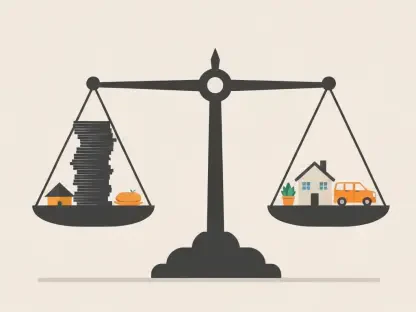In an era where digital banking is no longer a luxury but a necessity, the financial sector is witnessing seismic shifts as institutions strive to meet modern consumer demands. One striking development capturing attention is the proposed $78.3 billion acquisition of Comerica by Fifth Third Bank, a Cincinnati-based institution aiming to redefine its place in the industry. This deal, positioning Fifth Third among the top-10 banks with combined assets exceeding $291 billion, raises critical questions about the future of customer-centric technology and market expansion. This roundup gathers diverse opinions, tips, and reviews from industry leaders, analysts, and tech experts to explore how this merger could reshape digital banking, spotlighting innovative tools, strategic growth, and the challenges ahead.
Diverse Perspectives on Digital Transformation
Mobile App Innovations: A Game-Changer or Just Hype?
Industry observers have noted Fifth Third’s aggressive push to revamp its mobile app, transitioning from a basic “Goals” section to a more dynamic “Plan” financial hub designed for tracking spending and subscriptions. Many tech analysts praise this shift for its intuitive design, suggesting that features like cash flow management and direct deposit switching address core user needs effectively. Their view is that such updates could set a new standard for user-friendly banking interfaces if executed well.
However, not all feedback is unanimously positive. Some banking consultants express skepticism about user adoption rates, pointing out that the digital space is already crowded with similar tools from competitors. They argue that while the updates are promising, Fifth Third must ensure these features stand out through unique value propositions or risk blending into the background of generic banking apps.
A third perspective comes from fintech developers who emphasize the importance of continuous iteration based on user feedback. They recommend that Fifth Third leverage data analytics to refine these app enhancements over the next few years, ensuring that customer pain points are addressed promptly to maintain engagement and loyalty.
Financial Wellness: Redefining Banking’s Purpose
Another focal point in discussions is Fifth Third’s pivot toward financial wellness, moving beyond mere transactions to offer holistic financial health tools. Consumer advocacy groups applaud this direction, highlighting how features that visualize spending patterns over extended periods empower users to make informed decisions. They see this as aligning with a broader industry trend of banks acting as financial advisors rather than just service providers.
Contrarily, some financial planners caution against overcomplicating these tools, warning that diverse user bases may struggle with overly complex interfaces. Their tip is for Fifth Third to balance innovation with simplicity, ensuring that actionable insights remain accessible to customers of varying financial literacy levels.
Technology integrators add a different angle, suggesting that embedding educational content within the app could enhance this wellness focus. They propose short tutorials or tips on budgeting and saving, integrated seamlessly into the user experience, as a way to deepen customer engagement without overwhelming them with technical jargon.
Security Measures: Building Trust in a Digital Age
The introduction of the SmartShield fraud center, allowing customers to upload suspicious communications for expert analysis, has sparked significant conversation. Cybersecurity specialists commend this proactive approach, viewing it as a step ahead in an industry often criticized for reactive fraud prevention. They believe such features could become a competitive edge, particularly as digital threats grow more sophisticated.
On the other hand, regional banking analysts note potential variations in customer trust and adoption across different markets. They suggest that Fifth Third tailor its communication strategies to address local concerns, ensuring that users in diverse areas feel confident in utilizing these security tools without hesitation.
A contrasting opinion from user experience designers focuses on the need for transparency in how fraud analysis is conducted. Their advice is to provide clear feedback to customers after submissions, such as updates on investigation progress, to maintain trust and avoid perceptions of the tool being a mere formality rather than a robust safety net.
Strategic Growth Through Comerica Integration
The Comerica acquisition itself draws varied insights, especially regarding its role in scaling Fifth Third’s digital reach. Market strategists highlight the potential for this merger to amplify the bank’s customer base, providing a larger pool for testing and refining digital tools. They see this as a critical opportunity to gather feedback that could shape app functionalities over the coming years, starting from now through at least 2027.
Fintech collaboration experts weigh in on the integration process, pointing to Fifth Third’s partnerships with companies like Atomic and the use of APIs to control user experience. They contrast this with smaller past acquisitions, noting that the scale of the Comerica deal demands even more seamless technological blending, possibly through AI tools like the virtual assistant Jeanie to ease customer transitions.
Some financial analysts, however, raise concerns about cultural and operational alignment post-merger. Their perspective is that without a clear integration roadmap, the deal risks diluting Fifth Third’s digital focus. They urge prioritizing consistent branding and user experience across both entities to avoid fragmenting customer trust during this pivotal growth phase.
Key Takeaways from the Banking Community
Beyond specific features and strategies, the broader banking community offers practical lessons from Fifth Third’s ambitious moves. Many agree that prioritizing user-friendly design is non-negotiable in today’s digital landscape, with tips centering on simplifying navigation while embedding powerful tools. There’s also a consensus on integrating security not just as a feature but as a trust-building cornerstone, a lesson applicable to any institution aiming to stand out.
Another shared insight is the value of strategic partnerships in accelerating innovation without losing control over the customer journey. Experts suggest that smaller banks observe how Fifth Third balances in-house development with external collaborations, potentially adopting similar models to enhance their own offerings.
For customers evaluating digital banking options, the advice is to focus on tools aligning with personal financial goals, whether it’s robust budgeting features or proactive security measures. This customer-centric lens, echoed across opinions, underscores the evolving expectation that banks serve as partners in financial success, not just transactional hubs.
Reflecting on a Transformative Moment
Looking back, the discourse surrounding Fifth Third Bank’s acquisition of Comerica and its digital banking overhaul reveals a multifaceted push toward innovation, trust, and growth. The varied perspectives from industry analysts, tech experts, and consumer advocates paint a picture of both opportunity and challenge, highlighting the delicate balance required in such transformative endeavors. As the banking sector digests these developments, the emphasis on user experience and strategic expansion stands out as defining themes.
Moving forward, institutions and customers alike can take inspiration from these insights by exploring how digital tools fit into broader financial strategies. A practical next step involves closely monitoring how Fifth Third navigates integration challenges and app refinements, using these lessons to inform personal or organizational banking choices. Additionally, delving into industry reports or joining financial tech forums could provide deeper understanding and keep stakeholders ahead of emerging trends in this dynamic space.









